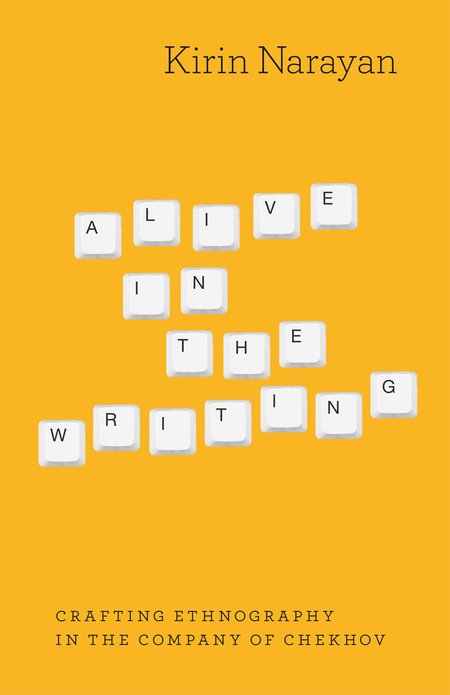
Kirin Narayan’s book Alive in the Writing: Crafting Ethnography in the Company of Chekhov is a detailed exposition on writing to life. Though aspiring authors across genres will no doubt find it useful, its specific focus is writing that either derives from ethnography directly, or imbibes ethnographic aspects. Creative non-fiction is one example of a genre that encompasses this kind of writing, and is a growing if still niche field. It lends itself well to academics who feel compelled to tell stories, whose lives may get intertwined with those they study and interact with, and whose disciplines may not fully embrace stories that fall outside their epistemological boundaries.
Following a Preface that speaks to Narayan’s choice to write about and with Chekhov (who stumbled into her manuscript when a friend recommended his 1895 book Sakhalin Island for its ethnographic aspects, and stayed because of the way he provokes a sense of aliveness in writing), the bulk of Alive in the Writing is divided into five sections. Story and Theory, Place, Person, Voice and Self are each organised around developing different elements of writing.
In Story and Theory, Narayan borrows from cultural anthropologist Renalto Rosaldo to note that stories are ‘incipiently analytic, and that in the sequence of reasoning, analysis has a narrative form’ (p. 8). Writing a coherent story that derives from fieldwork requires organising disparate field notes, finding and assembling interesting stories, and building on them in very organic ways to represent ideas, and perhaps social analysis.
Place encourages writers to attend to all their senses while writing of a place - attentive to popular imaginations and representations of it, and not succumbing to popular hyperbole. Doing this allows for emotional, visceral, and specifically place-based description, where place is not just a backdrop, but an actor in social relations. It changes (form) across seasons, and is made and remade by people and their labour across time.
Person describes how writers can craft characters, moving from caricature and flat descriptions to round, embodied people. Descriptions of dress, comportment, habit, seemingly small details such such as tension in a person’s shoulder, or the constant blinking of the an from peering too long at a screen, poor teeth, the texture of the skin on one’s hands establish and mark class, history of a people, and their day to day routines.
Finding both your own Voice (often lost under the brambles that academic writing today sharply pokes us with) as well as the voices of those represented - their idiosyncracies, tone, local specificities - comprises the bulk of Chapter Five. This chapter also takes readers through the messy business of transcription, offering thoughts about when to include pauses and the multitude of non-verbal communication that punctuate conversations, and when to smooth them over into seamlessly flowing text.
Though many writers are reluctant to enter their stories, in Self Narayan offers meaningful ways to integrate our own experiences into our writing. Rather than thinking of this as an interlude, or a narcissistic foray, she encourages readers to write about embodied experiences in ways that further stories, represent transformations of the self through the fieldwork context, and add to a larger picture of shared experiences.
Each section is meant to draw out further detail about each element, building layers upon each other. Boldface prompts follow each discursive foray into writing advice, and encourage freewriting.
The prompts alternate between writing one’s own perspective, while also encouraging writers to glean and include those of the people they are writing about. The Postscript offers a number of eminently practical tips.
Perhaps the exercise I found most useful was Narayan’s prompt almost certainly designed to counter writer’s block - or the sluggishness we often find ourselves melting into when we sit down to write.
“Write a few lines about where you are as you’re trying to write.”
This prompt appears a third through the book, and is a reminder to attend to the sensuousness of the place we describe - its sights, sounds, smells and feel.
I have used this seemingly innocuous prompt almost every time I have begun to write for the day. It is an easy prompt in some ways, because it does not require that you conjure anything from memory, notes, or imagination. It just requires that you be fully present and ‘attentive… to life itself’ (p. xi) - an ethnographic trick.
I am reproducing here, in all its unedited, clunky awkwardness, my first attempt to answer this prompt, and perhaps a clear revelation of myself. I would like to imagine most writing begins like this - in short, jerky moves, before time, revisions and grace transforms into timeless elegance.
As I sit at my laptop to write, one ear cocked to the Tapo app on my phone, through which I see my sleeping baby, the lines of dirt in a crease in the dining table draw my attention. Outside, the warm afternoon sun draws patterns and shadows on the floor, including of the star-shaped Christmas lights we have put up but never use. The sound of hammers and shovels obstinately pierce through the closed windows, never ending reminders of the monstrously large building coming up outside our living room, soon to drown it in shadows. The otherwise neat room is punctuated by my daughter’s living presence - a pair of green shorts on a bench, scraps of colourful paper on the coffee table. A constant reminder of her warm, beautiful life.
Cite: Narayan, Kirin. Alive in the writing: Crafting ethnography in the company of Chekhov. University of Chicago Press, 2012.
***
Natasha is looking for the right tree to spend the rest of her life under.
21 April 2023